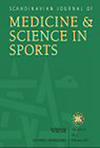精英运动员长期去适应对心脏尺寸和峰值摄氧量的影响。
IF 3.8
2区 医学
Q1 SPORT SCIENCES
引用次数: 0
摘要
这项纵向观察研究旨在确定运动员心脏的心室尺寸是否保持平衡,并与精英运动员长期去适应后的峰值摄氧量(vo2峰值)成正比。对14名男子混合型运动员(7名足球运动员、7名手球运动员)在精英水平和退役后进行心脏磁共振成像和心肺运动测试。在基线和随访中,将运动员与14名年龄匹配的对照组进行横断面比较。采用非参数检验进行统计分析。描述性统计以中位数[Q1, Q3]表示。据报道,从基线开始,运动员继续进行精英运动5年[2,9],随后退役12年[7,14]。左室舒张末期容积(LVEDV)下降17% (261 mL至222 mL, p < 0.001)。右心室舒张末期容积(RVEDV)下降14% (266 mL至232 mL, p < 0.001)。左房收缩末期容积减少16% (94 mL ~ 82 mL, p < 0.05)。峰值摄氧量(VO2peak)下降17% (3.96 L/min至3.37 L/min, p < 0.001)。与对照组相比,退役运动员之间没有差异。运动员LVEDV和RVEDV在基线(rs = 0.92, p < 0.001)和随访(rs = 0.92, p < 0.001)时达到平衡。降噪后LVEDV、RVEDV与VO2peak指标保持不变。在这组优秀运动员中,运动诱导的心脏重塑在长期去调节后是可逆的。LVEDV和RVEDV下降并保持平衡,与vo2峰值成正比。这项研究表明,心脏对运动的适应是生理的。然而,在对耐力表现要求较高的学科中,需要更多的研究来调查运动诱导的心脏重构的可逆性。本文章由计算机程序翻译,如有差异,请以英文原文为准。
Effects on Cardiac Dimensions and Peak Oxygen Uptake After Long-Term Deconditioning in Elite Athletes.
This longitudinal observational study aimed to determine if ventricular dimensions of the athlete's heart remain balanced and proportional to peak oxygen uptake (VO2peak) following long-term deconditioning in elite athletes. Fourteen mixed-type male athletes (7 soccer, 7 handball players) were prospectively evaluated with cardiac magnetic resonance imaging and cardiopulmonary exercise testing while active at elite level and after retirement. Athletes were cross-sectionally compared to 14 age-matched controls at baseline and follow-up. Statistical analysis was performed using nonparametric tests. Descriptive statistics are presented as median [Q1, Q3]. Since baseline, athletes reported continued elite sports for 5 [2, 9] years followed by retirement for 12 [7, 14] years. Left ventricular end-diastolic volume (LVEDV) decreased by 17% (261 mL to 222 mL, p < 0.001). Right ventricular end-diastolic volume (RVEDV) decreased by 14% (266 mL to 232 mL, p < 0.001). Left atrial end-systolic volume decreased by 16% (94 mL to 82 mL, p < 0.05). Peak oxygen uptake (VO2peak) decreased by 17% (3.96 L/min to 3.37 L/min, p < 0.001). There were no differences between athletes after retirement compared to controls. LVEDV and RVEDV were balanced in athletes at baseline (rs = 0.92, p < 0.001) and follow-up (rs = 0.92, p < 0.001). LVEDV and RVEDV indexed to VO2peak remained unchanged after deconditioning. Exercise-induced cardiac remodeling was reversible after long-term deconditioning in this cohort of elite athletes. LVEDV and RVEDV decreased and remained balanced and proportional to VO2peak. This study indicates that cardiac adaptations to sports are physiological. However, more research is needed to investigate the reversibility of exercise-induced cardiac remodeling in disciplines with higher demands on endurance performance.
求助全文
通过发布文献求助,成功后即可免费获取论文全文。
去求助
来源期刊
CiteScore
7.90
自引率
4.90%
发文量
162
审稿时长
3 months
期刊介绍:
The Scandinavian Journal of Medicine & Science in Sports is a multidisciplinary journal published 12 times per year under the auspices of the Scandinavian Foundation of Medicine and Science in Sports.
It aims to publish high quality and impactful articles in the fields of orthopaedics, rehabilitation and sports medicine, exercise physiology and biochemistry, biomechanics and motor control, health and disease relating to sport, exercise and physical activity, as well as on the social and behavioural aspects of sport and exercise.

 求助内容:
求助内容: 应助结果提醒方式:
应助结果提醒方式:


